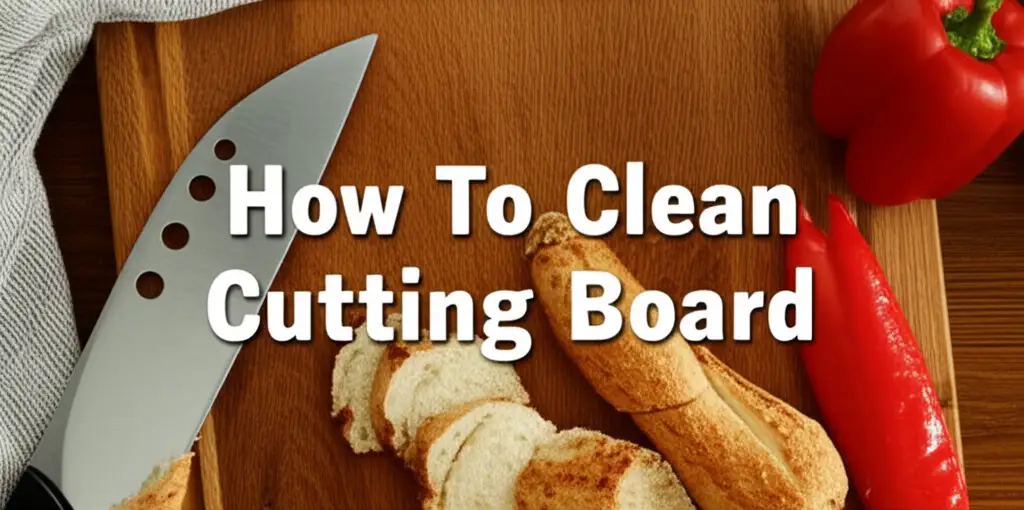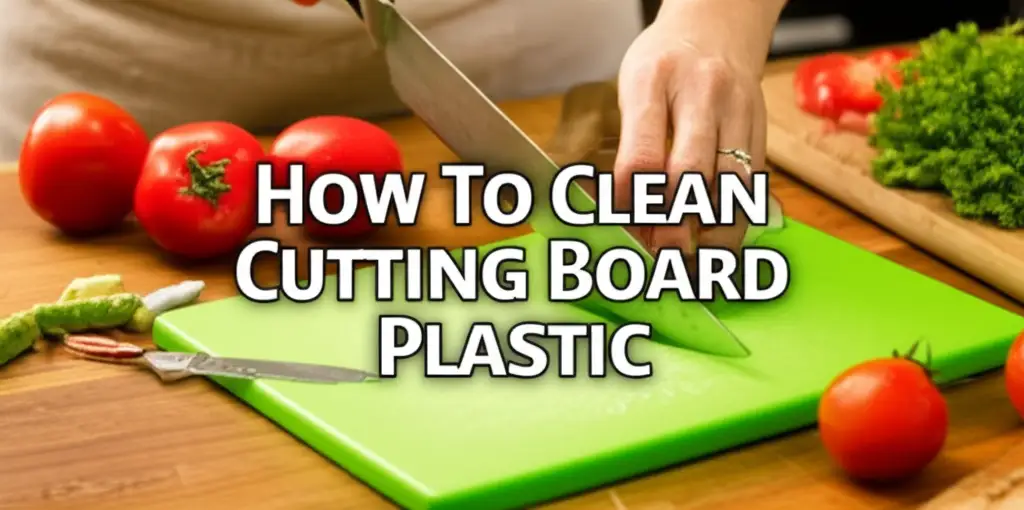· Kitchen Cleaning · 14 min read
How To Clean Cutting Board

How To Clean Your Cutting Board: A Comprehensive Guide
Cleaning a cutting board is more than just rinsing it under water. A clean cutting board keeps your kitchen safe. It stops harmful germs from spreading to your food. This guide teaches you how to clean cutting board types, remove stains, and sanitize surfaces. We will cover plastic, wood, and bamboo boards. You will learn the best methods for daily cleaning and deep sanitization.
This article provides essential steps for keeping your cutting boards pristine. We will discuss specific cleaning agents and tools. You will also find tips for daily maintenance and long-term care. By the end, you will know how to clean your cutting board properly every time.
Takeaway
- Wash cutting boards immediately after use to prevent germ growth.
- Use hot, soapy water for daily cleaning, or a dishwasher for plastic.
- Sanitize boards, especially after raw meat, using bleach or hydrogen peroxide.
- Condition wood and bamboo boards regularly to prevent drying and cracking.
- Remove stubborn stains and odors with natural ingredients like lemon and salt.
A clean cutting board is vital for kitchen hygiene. You must wash it thoroughly after each use. This prevents cross-contamination. Different materials need specific care for best results.
Essential Cleaning for Your Cutting Boards
You clean a cutting board by washing it with hot, soapy water immediately after use. Scrub the surface well to remove all food bits. Rinse it completely and let it air dry. For a deeper clean, especially after cutting raw meat, sanitize the board using a bleach solution or hydrogen peroxide.
Why Cleaning Your Cutting Board Matters for Food Safety
Your cutting board sees a lot of action. It handles raw meats, fresh vegetables, and everything in between. Each time you chop food, tiny grooves and scratches form on its surface. These small marks become hiding spots for food particles and bacteria. If you do not clean your cutting board properly, these germs can spread to your next meal. This process is called cross-contamination.
Cross-contamination can lead to foodborne illnesses. Bacteria like Salmonella and E. coli can make you very sick. Therefore, knowing how to clean cutting board materials well is critical. A dirty board puts your family’s health at risk. Regular and thorough cleaning removes these dangers. It keeps your food preparation safe.
Proper cleaning also extends the life of your cutting board. Food acids and moisture can damage the board material over time. Regular cleaning prevents this breakdown. It keeps your board looking good and working well for years. Think of cleaning as a protective measure for both your health and your kitchen tools. It is a simple step with big benefits.
Essential Supplies for Cutting Board Cleaning
Having the right tools makes cleaning your cutting board much easier and more effective. You do not need many items, but the right ones help. Soap and water are your basic allies. Hot, soapy water helps lift away food residues and grease. A good scrub brush or sponge is also necessary. It helps you reach into those small grooves and textures. I always keep a dedicated brush for my cutting boards.
For sanitizing, you will need a few extra items. Bleach is a powerful disinfectant, but it must be diluted properly. Hydrogen peroxide offers another effective sanitizing option. White vinegar and baking soda are great for natural cleaning. They remove odors and light stains. Lemon juice and salt also work wonders for brightening and deodorizing.
For wood and bamboo boards, you will want a special oil. Mineral oil or beeswax conditioning oil helps protect the wood. It keeps it from drying out and cracking. These oils also create a barrier against moisture and bacteria. Make sure to use food-grade mineral oil for safety. Keeping these supplies handy ensures you can always give your cutting board the care it needs.
- Basic Cleaning:
- Dish soap
- Hot water
- Scrub brush or sponge
- Sanitizing Agents:
- Household bleach (diluted)
- Hydrogen peroxide (3%)
- Natural Cleaners:
- White vinegar
- Baking soda
- Lemon
- Coarse salt
- Wood/Bamboo Care:
- Food-grade mineral oil or board conditioner
- Soft cloth
How to Clean Plastic Cutting Boards Effectively
Plastic cutting boards are popular because they are often dishwasher-safe. This makes cleaning very convenient. After each use, wash your plastic board with hot, soapy water. Use a stiff brush to scrub off any food particles. You want to remove all visible debris. Rinse it thoroughly under running water. Then, either place it in the dishwasher on a hot cycle or let it air dry completely.
For a deeper clean and sanitization, especially after cutting raw meat or poultry, use a bleach solution. Mix one teaspoon of liquid household bleach with one quart of water. Pour this solution over your plastic cutting board. Let it sit for several minutes, about five minutes. This contact time helps kill bacteria. Afterward, rinse the board completely with clean water. Make sure no bleach residue remains. Air dry the board before storing it.
Plastic boards can sometimes stain or hold onto odors. To remove these, sprinkle baking soda over the wet board. Rub it with a sponge or brush. The baking soda acts as a mild abrasive. It also absorbs odors. For tough stains, you can make a paste with baking soda and a little water. Apply it to the stain, let it sit, then scrub and rinse. Keeping your plastic board clean this way ensures it stays hygienic and ready for your next meal prep. You can learn more about specific techniques for plastic boards here: How To Clean Cutting Board Plastic.
- Daily Cleaning:
- Wash with hot, soapy water immediately after use.
- Scrub thoroughly with a brush.
- Rinse well.
- Dishwasher-safe: Use a hot cycle.
- Hand-wash: Air dry completely.
- Sanitizing (Post-Raw Meat):
- Mix 1 teaspoon bleach with 1 quart water.
- Apply solution to board for 5 minutes.
- Rinse thoroughly to remove all bleach.
- Air dry.
- Removing Stains/Odors:
- Sprinkle baking soda and scrub.
- For tough stains, make a baking soda paste, apply, let sit, then scrub and rinse.
Deep Cleaning and Caring for Wood and Bamboo Cutting Boards
Wood and bamboo cutting boards are beautiful and durable. They require different care than plastic boards. Do not put them in the dishwasher. The high heat and prolonged moisture can cause them to warp, crack, or split. Instead, always hand-wash them. After each use, wash your wood or bamboo board with hot, soapy water. Use a dishcloth or sponge. Scrub both sides to prevent warping from uneven drying. Rinse quickly and thoroughly. Then, dry it immediately with a towel. Let it air dry completely standing on its edge before storing. This allows air to circulate around all surfaces.
For deeper cleaning and sanitization, you can use a few methods. White vinegar is a natural disinfectant for wood boards. Spray or wipe your board with undiluted white vinegar. Let it sit for a few minutes, then rinse and dry. Vinegar helps kill germs and neutralize odors. Another option is a lemon and salt scrub. Sprinkle coarse salt over the board. Cut a lemon in half and use it to scrub the salt into the wood. The lemon’s acid cleans and brightens, while the salt acts as an abrasive. Rinse well after scrubbing. This method also helps remove stains and refresh the surface.
Conditioning is vital for wood and bamboo boards. It keeps them from drying out and cracking. Apply food-grade mineral oil or a board conditioner once a month, or more often if the board looks dry. Pour a small amount of oil onto the board. Use a clean cloth or paper towel to rub it into the wood. Let it soak for several hours or overnight. Then, wipe off any excess oil. This process protects the wood and keeps it looking new. For specific care tips, you can read more here: How To Clean Bamboo Cutting Board and How To Clean Wooden Chopping Board.
- Daily Cleaning (No Dishwasher):
- Hand-wash with hot, soapy water.
- Scrub both sides to prevent warping.
- Rinse quickly and thoroughly.
- Towel dry immediately, then air dry standing on edge.
- Deeper Clean/Sanitize:
- White Vinegar Method: Spray undiluted white vinegar, let sit for a few minutes, rinse, and dry.
- Lemon and Salt Scrub: Sprinkle coarse salt, scrub with half a lemon, rinse well.
- Conditioning/Maintenance:
- Apply food-grade mineral oil monthly or when dry.
- Rub oil into the wood, let soak (hours/overnight).
- Wipe off excess oil.
Sanitizing Your Cutting Board After Raw Meat Use
Sanitizing your cutting board after it has touched raw meat, poultry, or fish is extremely important. This step kills harmful bacteria like Salmonella, E. coli, and Listeria. These bacteria can cause serious foodborne illnesses. Washing with soap and water alone is not enough to eliminate them. You need a strong sanitizing agent to ensure your board is safe for future use.
For plastic cutting boards, a diluted bleach solution works very well. After washing your board with soap and water, mix one teaspoon of liquid household bleach with one quart of water. Pour this mixture over the entire surface of the board. Let it sit for at least five minutes. This contact time allows the bleach to kill the bacteria. After five minutes, rinse the board very thoroughly under running water. Ensure all bleach residue is gone. Then, let it air dry completely. Never mix bleach with other cleaners like vinegar or ammonia, as this creates dangerous fumes.
For wood and bamboo cutting boards, which should not use bleach, hydrogen peroxide is a good alternative. After washing your board with soap and water, spray a 3% hydrogen peroxide solution onto the surface. Let it bubble and sit for 5-10 minutes. Hydrogen peroxide breaks down into water and oxygen, leaving no harmful residue. Rinse the board well with clean water and dry it immediately with a clean towel. You can also use white vinegar as a sanitizing spray for wood, applying it after washing and letting it sit before rinsing. For comprehensive details on sanitizing wooden boards after raw meat, refer to How To Clean Wood Cutting Board After Raw Meat.
- For Plastic Boards:
- Wash with soap and water first.
- Mix 1 tsp bleach with 1 quart water.
- Apply solution for 5 minutes.
- Rinse very thoroughly.
- Air dry.
- For Wood/Bamboo Boards:
- Wash with soap and water first.
- Spray 3% hydrogen peroxide solution.
- Let sit for 5-10 minutes.
- Rinse well and dry immediately.
- Alternatively, use undiluted white vinegar as a spray.
Removing Stubborn Stains and Odors from Your Cutting Board
Cutting boards often pick up stains and odors over time. Garlic, onions, fish, and colorful foods like beets can leave their mark. But you do not have to live with them. There are simple, effective ways to make your board look and smell fresh again. I often use natural ingredients for this, as they are safe and work wonders.
One of my favorite methods for removing stains and odors is the lemon and salt scrub. This works great on both wood and plastic boards. First, sprinkle a generous amount of coarse salt (like kosher salt or sea salt) over the stained area of your board. Then, cut a lemon in half and use the cut side to scrub the salt into the surface. The salt acts as a gentle abrasive, lifting away stains and food particles. The lemon’s natural acidity helps to bleach out stains and neutralize odors. Scrub for several minutes, focusing on problem areas. After scrubbing, let the mixture sit on the board for 5-10 minutes. Then, rinse thoroughly with hot water and dry the board.
For particularly stubborn odors or general freshening, baking soda is another excellent option. Sprinkle baking soda generously over your wet cutting board. Let it sit for 15-20 minutes. Baking soda is known for its odor-absorbing properties. You can also make a paste with baking soda and a little water. Spread this paste over the stained or smelly areas. Scrub gently with a sponge or brush. After letting it sit, rinse the board completely. For plastic boards, you can also consider a light bleach solution for very tough stains, but remember to rinse thoroughly. These simple tricks help keep your cutting board clean and free of unwanted smells.
- Lemon and Salt Scrub (Wood & Plastic):
- Sprinkle coarse salt on the stained area.
- Use half a lemon to scrub the salt into the board.
- Let sit for 5-10 minutes.
- Rinse thoroughly with hot water and dry.
- Baking Soda (Odors & Stains):
- Sprinkle baking soda over wet board, let sit 15-20 minutes.
- Or, make a paste with baking soda and water, apply, scrub, rinse.
- For Tough Plastic Stains:
- A light, diluted bleach solution can be used, followed by thorough rinsing.
Daily Maintenance and Storage Tips for Longevity
Proper daily care and storage are key to making your cutting boards last. A little effort each day prevents big problems later. It keeps your boards hygienic and in good shape. Always aim to clean your cutting board immediately after each use. Do not let food residues dry on the surface. Dried food is harder to remove and can become a breeding ground for bacteria.
After cleaning, drying is crucial. For plastic boards, you can let them air dry in a dish rack. For wood and bamboo boards, towel dry them thoroughly first. Then, stand them on edge or use a drying rack that allows air to circulate around all sides. This prevents moisture from getting trapped, which can lead to warping, cracking, or mold growth. Never store a wet or damp cutting board.
Where you store your cutting board also matters. Store boards in a dry, well-ventilated area. Avoid stacking them flat if they are still slightly damp, as this traps moisture. Vertical storage in a rack or leaning against a wall is ideal. This allows for continuous air circulation. Keep them away from direct heat sources like ovens or radiators. Extreme temperature changes can stress wood and cause it to crack. For wood and bamboo boards, remember to oil them regularly. This replenishes moisture and creates a protective barrier. Following these simple steps will ensure your cutting boards remain safe and serve you well for many years.
- Immediate Cleaning:
- Wash boards right after each use.
- Thorough Drying:
- Plastic: Air dry in a dish rack or dishwasher.
- Wood/Bamboo: Towel dry, then air dry standing on edge.
- Never store a damp board.
- Proper Storage:
- Store in a dry, well-ventilated area.
- Use vertical storage (rack, leaning) for air circulation.
- Keep away from direct heat sources.
- Regular Oiling (Wood/Bamboo):
- Oil boards regularly to prevent drying and cracking.
FAQ Section
How often should I deep clean my cutting board?
You should deep clean and sanitize your cutting board after every use with raw meat, poultry, or fish. For general use with fruits, vegetables, and bread, a thorough wash with hot, soapy water is usually enough daily. Consider a deeper clean with vinegar or hydrogen peroxide weekly or bi-weekly.
Can I use bleach on all types of cutting boards?
No, you should only use diluted bleach on plastic cutting boards. Bleach can dry out, damage, and potentially discolor wood and bamboo boards. For wood and bamboo, use natural alternatives like white vinegar or hydrogen peroxide for sanitizing. Always rinse plastic boards thoroughly after using bleach.
What is the best way to remove knife marks from a cutting board?
For plastic boards, severe knife marks mean it is time to replace the board. For wood boards, light knife marks can sometimes be sanded out carefully with fine-grit sandpaper, followed by re-oiling. Deep marks on any board type create bacterial traps and may require replacement.
How do I prevent my wooden cutting board from warping?
To prevent warping, always wash both sides of your wooden board even if only one side was used. Dry it immediately with a towel. Then, allow it to air dry completely while standing on its edge. This ensures even drying and prevents moisture from accumulating on one side. Also, oil your board regularly.
Is it better to use plastic or wooden cutting boards?
Both plastic and wooden cutting boards have pros and cons. Plastic boards are often dishwasher safe and can be easily bleached. Wooden boards are naturally self-healing to a degree and can be gentler on knives. The most important factor is proper cleaning and maintenance for whichever type you choose.
Can I use olive oil to condition my wooden cutting board?
It is not recommended to use olive oil or other cooking oils (like vegetable oil) to condition wooden cutting boards. These oils can go rancid over time, leading to unpleasant odors and flavors in your food. Instead, always use food-grade mineral oil or a specific board conditioning oil.
Conclusion
Keeping your cutting board clean is not just about appearances. It is a critical step for kitchen safety and preventing foodborne illnesses. We have explored how to clean cutting board types, from plastic to wood and bamboo. You now know the daily washing routines and the deeper sanitization methods for handling raw meats. Remember, different materials need specific care to stay hygienic and last longer.
By regularly cleaning, sanitizing, and properly storing your cutting boards, you protect your family’s health. You also extend the life of these essential kitchen tools. Make cleaning your cutting board a consistent part of your cooking routine. This small effort yields big rewards in terms of cleanliness and food safety. Keep your kitchen a safe and healthy space.
- cutting board cleaning
- kitchen hygiene
- wood board care




